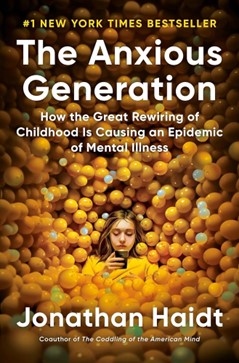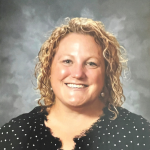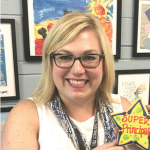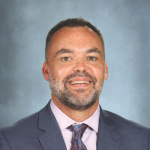
The Age of Anxiety
The Anxious Generation says that social media and lack of unsupervised play are making children more prone to mental illness.
Topics: Social Emotional Learning, Health and Wellness
NAESP members recently shared their insights on The Anxious Generation: How the Great Rewiring of Childhood Is Causing an Epidemic of Mental Illness by Jonathan Haidt—a timely topic for schools across the country.


Encouraging Antifragility
How did the book resonate with you as a school leader and a parent?
The argument that the author makes is that students are under-supervised in the digital world and over-supervised in the real world. Haidt uses the phrase “antifragile” to describe kids—implying that kids grow stronger as they experience and persevere through minor stressors. Many parents, however, work to intervene before kids experience conflict and stress, preventing them from developing resilience and healthy interpersonal skills.
Did anything you learned in this book make you want to adapt your leadership approach?
The book made me question my approach to resolving conflicts between students. There can be tremendous growth in allowing students to “sit in the struggle” and learn valuable skills while navigating difficulties with peers.
The book also made me question how much we might possibly over-rely on technology as a tool for learning. As we look at new instructional tools, we will be evaluating resources specifically to consider more hands-on opportunities and more tools that facilitate inter-student cooperation and collaboration.
How did the book confirm what you already suspected about student mental health?
The book confirmed what many of us have suspected about the potential dangers of overreliance on technology and social media. If anything, it provided me with the confidence to trust what I’ve known in my gut: that students need more opportunities for unstructured outdoor play and less screen time.

Knowledge Informs Change
What was the book’s main message?
Although many factors have influenced the mental health of our students since the 1990s, the most significant are smartphones/social media and overprotection. That said, it is not too late to make a change for our students.
You lead at the middle level. How do the lessons in this book apply to middle schoolers?
[I plan on] increasing professional development to add play in middle school.
How did the ideas in this book align with rules on smartphones in your school?
It reinforces the rule changes we made regarding reducing student access to cellphones.
What will you take forward as you reflect on the book?
Knowledge is power. This book helped me put together the many pieces I saw in my school community, reminding me of the changes we can make to influence the success of our students and families.

Say No to Screens
What’s a snapshot of what this book explores?
The book has four main takeaways that will help us, as a society, work toward improving adolescent mental health and well-being:
- No smartphones before high school.
- No social media before age 16.
- Create and maintain phone-free schools.
- Embrace more unsupervised play and independence.
What parts of the book resonated the most with you?
The notion of returning to a tech-free childhood experience is really the cornerstone of the book. As a principal and a parent of tween children, the idea of phone-free schools and more playful schools is exciting. Similarly, allowing children more freedom and independence is necessary. As Haidt says, “Try not to fill up most afternoons with adult-supervised ‘enrichment’ activities. Find a way your children can just hang out with other children.”
What strategies do you plan on using in your school?
First, we need to get our children off screens and social media, then we need to give them the space and independence to play, learn, explore, and grow. Our PBIS Home Connection program encourages children to develop new patterns and goals and bring them back to school.
How has this book helped you grow as a leader?
It helped me grow as an elementary principal and as a parent by providing clear and concrete action steps. “Practice letting your kids out of your sight without them having a way to reach you,” Haidt suggests. As a parent, this is helpful advice to help foster independence. In terms of school recess, Haidt suggests having fewer supervised, adult-directed games to move toward empowering children to lead games and navigate problem-
solving situations on their own. The book helped me reframe my thinking about the necessity of keeping students off screens—especially phones—and allow for more free play—inside and outside the school.
Why should other school leaders read this book?
It’s a must-read for information on why phone and social media use is so detrimental to young teens’ mental health. We know that excessive technology use and social media access during school hours is distracting, but this book puts forth clear steps for us as school leaders.

A New Emphasis on Play
What did you learn about technology’s effects on childhood development?
For years, children have been overprotected in real-world settings [while being] underprotected in their use of technology. This has made a great impact on the ways they function and their overall mental health.
How will you incorporate the book’s lessons into your school’s mission and vision?
I will use this new learning as another way to connect staff to our school’s vision, which emphasizes empowering students as learners. The skills learned at a young age during free play are critical to encouraging risk-taking, collaborating with others, and accessing—but not relying solely upon—assistance from others. It is critical to develop these skills to become empowered as a learner.
How have you used what you’ve gleaned from the book to boost staff professional learning?
Even with pressures for academic accountability, our primary grades ensure that students have time for free play. In the past year, a few teachers have elevated the value of outdoor education. I used information from the book to support our staff in considering the importance of educating the whole child.
What themes in this book will you carry with you in your school leadership?
As a leader, this book helped me reflect on two specific themes in our work with children at our school. [It] reinforced the importance of providing opportunities for free play during the school day; for technology use, it heightened the value of teaching online safety and the connections we make between in-person and digital citizenship.

